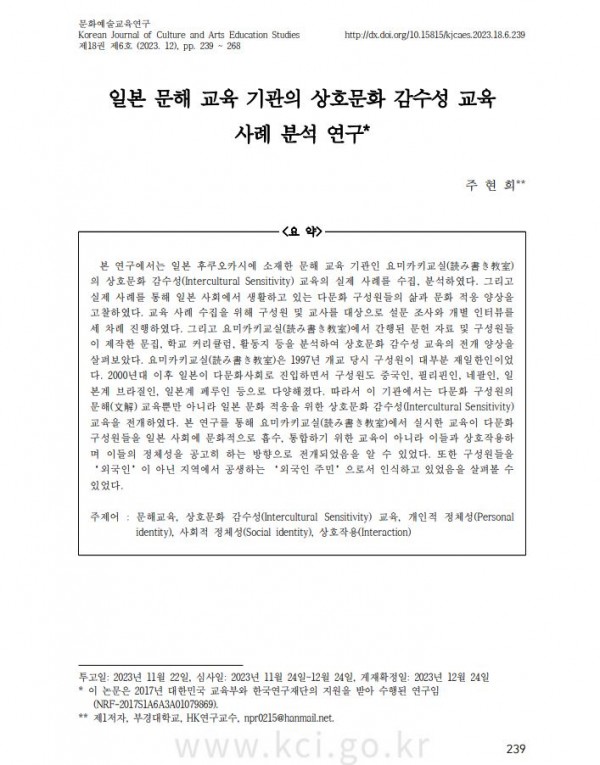본문
본 연구에서는 일본 후쿠오카시에 소재한 문해 교육 기관인 요미카키교실(読み書き教室)의 상호문화 감수성(Intercultural Sensitivity) 교육의 실제 사례를 수집, 분석하였다. 그리고 실제 사례를 통해 일본 사회에서 생활하고 있는 다문화 구성원들의 삶과 문화 적응 양상을 고찰하였다. 교육 사례 수집을 위해 구성원 및 교사를 대상으로 설문 조사와 개별 인터뷰를 세 차례 진행하였다. 그리고 요미카키교실(読み書き教室)에서 간행된 문헌 자료 및 구성원들이 제작한 문집, 학교 커리큘럼, 활동지 등을 분석하여 상호문화 감수성 교육의 전개 양상을 살펴보았다. 요미카키교실(読み書き教室)은 1997년 개교 당시 구성원이 대부분 재일한인이었다. 2000년대 이후 일본이 다문화사회로 진입하면서 구성원도 중국인, 필리핀인, 네팔인, 일본계 브라질인, 일본계 페루인 등으로 다양해졌다. 따라서 이 기관에서는 다문화 구성원의 문해(文解) 교육뿐만 아니라 일본 문화 적응을 위한 상호문화 감수성(Intercultural Sensitivity) 교육을 전개하였다. 본 연구를 통해 요미카키교실(読み書き教室)에서 실시한 교육이 다문화 구성원들을 일본 사회에 문화적으로 흡수, 통합하기 위한 교육이 아니라 이들과 상호작용하며 이들의 정체성을 공고히 하는 방향으로 전개되었음을 알 수 있었다. 또한 구성원들을 ‘외국인’이 아닌 지역에서 공생하는 ‘외국인 주민’으로서 인식하고 있었음을 살펴볼 수 있었다.In this study, actual cases of intercultural sensitivity education at the Yomikaki-Institute, a literacy education institution based in Fukuoka, Japan, were collected and analyzed. The Yomikaki-Institute has been operated mainly by private and local residents for 26 years since its opening in 1997. Most of the members of the Yomikaki-Institute were Koreans in Japan at the time of its opening. As Japan entered a multicultural society after the 2000s, its members diversified into Chinese, Filipino, Nepalese, Japanese Brazilians, and Japanese Peruvians. In addition to literacy education for multicultural members to adapt to Japanese society, this institution has provided intercultural sensitivity education for adaptation to Japanese culture. It was found that the education conducted in the Yomikaki-Institute was not aimed at culturally absorbing and integrating multicultural members into Japanese society, but rather at interacting with them and solidifying their identity. It could be seen that the members were recognized as 'foreign residents' who lived in symbiosis in the region, not as 'foreigners'.







